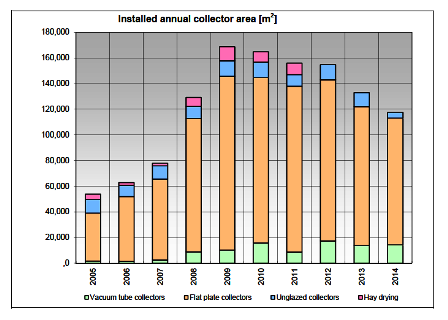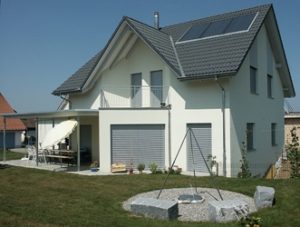Switzerland: Shift towards Multi-Family Housing Projects
September 21, 2015
In June, the Swiss Federal Office of Energy published its annual solar market report carried out by the solar energy association Swissolar (see the attached document in German and French). In 2014, sales of glazed collectors dropped by 7 %, down to 113,000 m² of absorber area. Vacuum tube collectors had a share of 13 %. The statistics also include 4,487 m² of unglazed collectors. The chart shows the shares of the different collector technologies over the years.
Source: Swissolar

The number of solar thermal plants newly installed in Switzerland has fallen dramatically, from 12,101 units in 2013 to 8,931 systems in 2014. The drop marks the country’s shift away from small units in single-family homes in favour of larger systems in multi-family buildings. The share of the multi-family segment grew from 35 % in 2013 to 60 % in 2014.
The huge increase is a result of the number of small systems decreasing more drastically than the market average. There is a decline in the construction of new single-family homes and in addition, the combination of PV and heat pump has become an increasingly popular alternative among homeowners. Heat pumps and PV are favoured in Switzerland’s new building code.
In 2013, 1,500 solar thermal plants were installed on multi-family buildings. In 2014, the number was up to 1,810. “Several of our members told us that they shifted their marketing focus towards multi-family buildings to compensate for the decline in the sales of small systems,” says David Stickelberger from Swissolar. He believes that these marketing efforts are responsible for the growth in the segment of large systems.
With a total installed collector area of 0.16 m² per inhabitant, Switzerland ranks 5th in Europe, according to ESTIF statistics.
CO2 tax will up heating oil prices
Solar heat is a central part of the Swiss energy strategy for 2050. Whilst the strategy framework for the energy strategy was adopted in 2011, many issues related to the next steps forward are currently under discussion. “To achieve a real shift towards renewable energies, it now needs growth, not stagnation,” Swissolar writes in a press release on 2 July. One important instrument to promote solar heating is the tax on CO2 emissions for space heating fuels. From 2016 on, the tax will be raised to 84 CHF per ton of CO2, which equals a price increase of 8 % on heating oil. One third of the tax money will then be used to fund incentive programmes for energy efficiency in buildings. What will ultimately become of the CO2 tax is still being discussed as part of the energy strategy.
Vacuum tubes gain market share
Among collector technologies, vacuum tubes are the only collector type which gained some momentum over the past year. With an increase of 2.8 %, vacuum tubes got to 14,403 m² of newly installed absorber area in 2014. This can be viewed as a sign of regained consumer trust in this type of collector. After hail damage several years ago, building insurers raised the prerequisites for vacuum tube collectors, but several companies – such as Helvetic Energy – have meanwhile adapted the collectors to meet the new requirements.
More collector imports
The market report also reveals that the share of imported collectors rose significantly: Regarding flat plate collectors, companies in Switzerland produced 67,406 m², whereas 65,750 m² were imported. At the same time, 34,500 m² were exported, mostly to Germany. Swissolar will investigate further which factors have been responsible for such a development, Stickelberger adds.
More information:
Swissolar: http://www.swissolar.ch/


